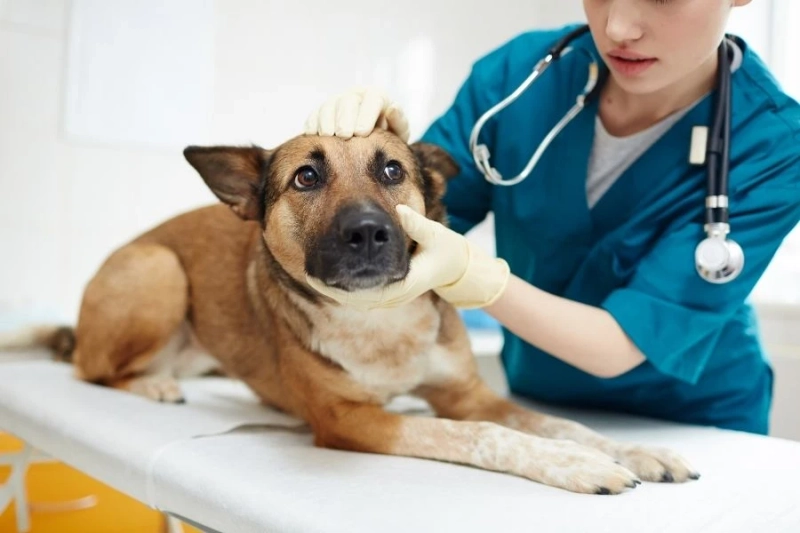Is your dog having a flat, reddened, spotty and oozing patch on its skin? Is it scratching its skin excessively and forms a hairless and painful area on the skin? If yes, then it suffers from the so-called hot spot. This is one of the most painful and uncomfortable skin conditions that your dog can have.
Hot spot in dogs
In medical terms, the hot spot is also called peritraumatic dermatitis. It is acute eczema that spreads in circular form. This itchy inflammation may get red and hot, and that’s why this condition is called as a hot spot. Often the suffered area may secrete a foul-smelling which sticks to the fur.
This disease can occur in any dog, but most of the time, the long-haired breeds such as Huskies, St. Bernard, and Golden Retriever are more prone to this condition. The areas which are most commonly affected in dogs are the ears, torso, or front of the legs.
Since moisture and warm temperature contribute to inflammation and can cause hot spots. One of the most common reasons for this skin condition in dogs is a Flea bite. As a result of increased itching-related licking, the wound becomes more infected with bacteria. Fungal infection, allergic reactions, and contact reaction to nettles are some of the key reasons which may create a hot spot in dogs.
Hot Spot symptoms
Typically, it is a circular, red, superficial skin inflammation that can flare up within a few hours. In the beginning, the hot spot in dogs is rather unpredictable. The long, thick coat of the hair makes it difficult to see the skin underneath. And, the hot spot is only discovered when it really inflames. Even many dog owners become aware of the injury through the foul smell of the wound secretion and the sticky fur around the spot.
Preferably, you will find inflammation on the back or trunk of the dog as well as on their neck, ears or the legs. Make sure to prevent the dog from scratching or licking while a hot spot is discovered. If it continues to lick the area, a deep hot spot will be formed. It’s better to go for hot spot treatment in dogs as soon as the injury is discovered.
Causes of hot spots in dogs
It is not a skin disease, but may arise from an underlying cause. The exact origin of this skin condition may vary and insignificant. Any small injury or an allergic reaction can develop into hot spot if its not treated properly. Apart from this, the following causes also support the spread of hot spot:
External ear infectionsFungal infections’Ectoparasite infestation and its bitesAnal gland problemsFood intolerance or allergiesUsually, the dog inflicts the hot spot on itself by scratching or licking the infected area. It tries to relieve the itching by licking but makes the situation worse. Germs and dirt may get into the wound and cause more itching.
When should one consult a vet?
If your dog is in pain from the hot spot, it is advisable to consult the vet immediately. Without proper treatment, there are chances that further spread is inevitable. The vet will first find out the cause and fix it. You can prepare yourself for the visit to vet when the skin change appeared first, how bad the dog scratches it, or whether your dog is having any kind of allergy.
How hot spot in dogs is treated?
If you discover hot spot in your dog for the first time, do not touch it! How a hot spot will be treated depends on the progression of inflammation. Your dog may be very sensitive to pain. Treating the cause of itchiness is the best solution.
If the condition is severe, the hot spot treatment in dogs will be very painful to the innocent animal. The vet will carefully shave the infected area and disinfects the skin. In most heavily encrusted wounds, there are chances that vet will remove the crust.
The dog will be given an antibiotic if the hot spot is very deep and infected due to bacteria. Put a ruff on the dog, if you cannot stop it from further licking. Anti-itch medication is also given to the dog. Cooling compresses are also beneficial to help recover the dog.
How to prevent a hot spot?
A good grooming is must to prevent a hot spot in dogs. It is always better to examine the dog’s coat, and check for parasites. Comb the long-haired dogs regularly. The warm and humid temperature promotes the development of hot spots. Always make sure to use a soft brush while combing as sharp-edge comb bristles cause small injuries.
In addition to the local treatemnt, you and your veterian must investigate the cause of hot spots, so as to prevent hot spots from forming. Good grooming is a must to prevent the hot spot. It is always must to keep the wound clean to protect it from any kind of infection.


